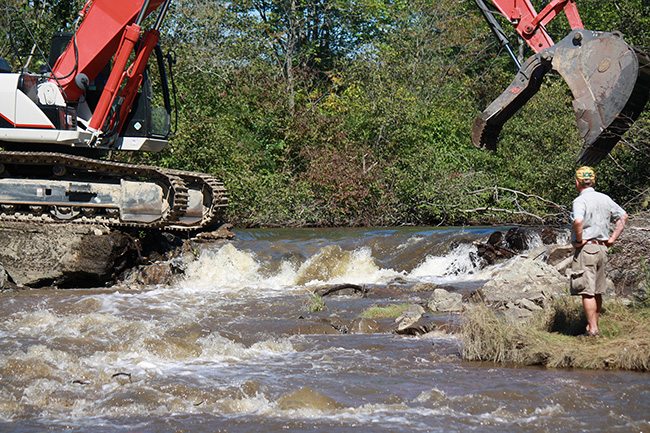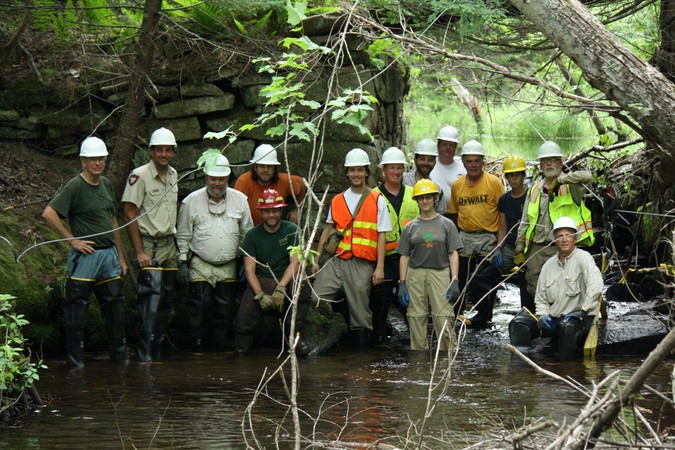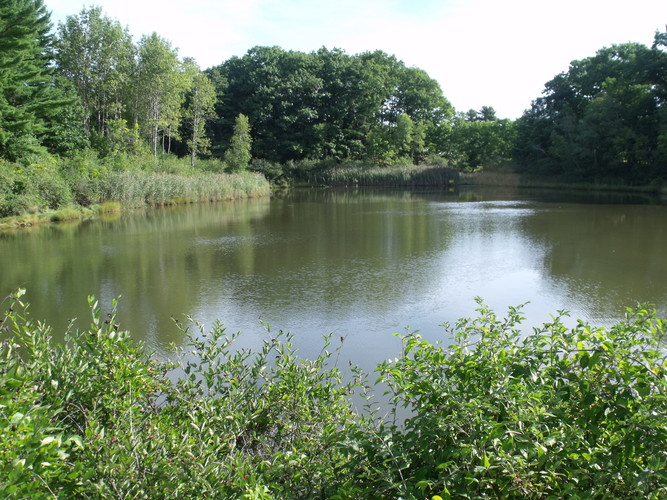The Wrack
The Wrack is the Wells Reserve blog, our collective logbook on the web.
The Wrack is the Wells Reserve blog, our collective logbook on the web.
Three small projects with outsize impact have been focusing the reserve's attention in this latter half of 2015. Completing these minor feats of engineering will improve the ecology of local watersheds for generations to come. Our science and stewardship team planned for months and years to set up these moments of action on Goff Mill Brook, Branch Brook, and the York River.
 On a sunny mid-September morning in Arundel, a 36-ton excavator lumbered toward Goff Mill Brook at a walker's pace and stationed itself beside a waist-high dam wrapped in brambles. A dozen onlookers stood transfixed as the no-nonsense machine stretched a 36-foot arm over the dam and dug in. A few minutes later, they cheered as the brook's flow accelerated from a trickle to a rush.
On a sunny mid-September morning in Arundel, a 36-ton excavator lumbered toward Goff Mill Brook at a walker's pace and stationed itself beside a waist-high dam wrapped in brambles. A dozen onlookers stood transfixed as the no-nonsense machine stretched a 36-foot arm over the dam and dug in. A few minutes later, they cheered as the brook's flow accelerated from a trickle to a rush.
Removing the antiquated dam from Goff Mill Brook reconnected seven miles of stream habitat to the Kennebunk River estuary. Now American eels, river herring, and other migratory fish coming in from the Gulf of Maine can explore rivulets they and their ancestors haven't sensed for more than six decades.
This small dam was built before the environmental consequences of such structures were fully appreciated. Maine has many of these "legacy" dams that wouldn't be permitted today.
Jake Aman managed the project for the reserve. He worked with the Sebago Chapter of Trout Unlimited under TU's Embrace-a-Stream program. The project gained the backing of the Maine Dept. of Marine Resources and the conservation community, and was approved by the Maine Dept. of Inland Fisheries and Wildlife. Additional funding and support were provided by The Nature Conservancy, U.S. Fish and Wildlife Service Gulf of Maine Coastal Program, the National Fish and Wildlife Foundation, and the Maine Outdoor Heritage Fund. Caribou Springs of Gilead, as the prime contractor, operated the excavator.
 Another Herculean task undertaken this summer was the removal of a four-foot-long wall of big granite blocks from Branch Brook — this time without the assistance of an excavator.
Another Herculean task undertaken this summer was the removal of a four-foot-long wall of big granite blocks from Branch Brook — this time without the assistance of an excavator.
Erosion had begun crumbling some old bridge abutments, which dropped massive chunks of granite into the brook, blocking fish passage. The de facto dam had to go, but with no way for heavy equipment to reach the site — how?
For this job, Jake contacted Steve Koenig at Project SHARE, who agreed to take on the task and double-bill it as a training exercise. By the time the July work day arrived, more than 20 people from nine conservation organizations had signed on to help and learn about the technique.
They removed one large stone at a time, using a manual winch and high line to hoist the blocks, lifting them just enough that they could slide down a steel cable to the stream bank. The work was slow and steady, but as blocks and debris were removed the upstream impoundment began to drain down. The last step, reopening the channel, signaled the beginning of better days for Branch Brook's aquatic life.
This project was an apt follow-up to fish ladder reconstruction at the KK&W Water District plant in 2013. Sea lamprey and brook trout now use that fishway, so they're now free to enter many more upstream tributaries for feeding and spawning.
Funding, technical support, and hands-on work for this effort were contributed by The Nature Conservancy, U.S. Fish and Wildlife Service Gulf of Maine Coastal Program, Atlantic Salmon Federation, and National Fish and Wildlife Foundation.
 Two small ponds along the York River will reconnect to the flow of tides in December after being essentially cut off from the estuary for years.
Two small ponds along the York River will reconnect to the flow of tides in December after being essentially cut off from the estuary for years.
Ancient culverts at the York Golf and Tennis Club have gradually failed, impeding natural tidal flow and causing poor drainage, stagnant water, and the possible loss of a maintenance road. After consulting with engineers and restoration experts, the club elected to replace the compromised culverts with new and larger conduits.
The restoration will create more than 5 acres of tidal salt marsh by returning ebb and flow to two impoundments. The project is expected to improve water quality, reduce the risk of flooding, and allow the salt marsh to migrate in response to rising seas. Tidal range will increase by 2 feet in one pond and 3½ feet in the other.
Salt marsh plants should colonize newly exposed areas naturally. The area should maintain itself for at least 75 years, demonstrating a cost-effective climate adaption technique.
Reserve scientists will map and measure vegetation in the spring and fall for the next three years. A tide monitor will verify the estimated tide range.
Partners in this project are the York Golf and Tennis Club, York Country Club, York Rivers Association, and Civil Consultants. The NOAA Restoration Center and Town of York both advised the group. The York Golf and Tennis Club, National Fish and Wildlife Foundation, Maine Coastal Program, and Rachel Carson National Wildlife Refuge provided funding.
From Watermark 32(2): Fall 2015